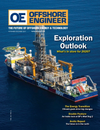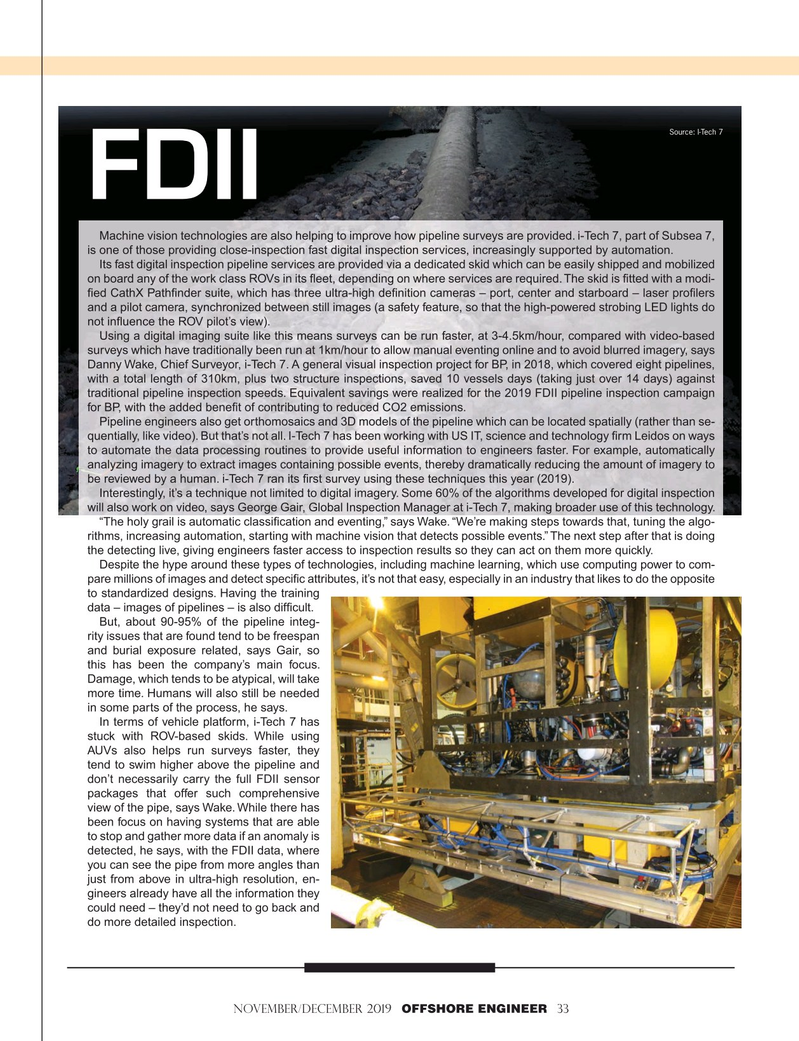
Page 33: of Offshore Engineer Magazine (Nov/Dec 2019)
Exploration Outlook
Read this page in Pdf, Flash or Html5 edition of Nov/Dec 2019 Offshore Engineer Magazine
Source: I-Tech 7
FDII
Machine vision technologies are also helping to improve how pipeline surveys are provided. i-Tech 7, part of Subsea 7, is one of those providing close-inspection fast digital inspection services, increasingly supported by automation.
Its fast digital inspection pipeline services are provided via a dedicated skid which can be easily shipped and mobilized on board any of the work class ROVs in its ? eet, depending on where services are required. The skid is ? tted with a modi- ? ed CathX Path? nder suite, which has three ultra-high de? nition cameras – port, center and starboard – laser pro? lers and a pilot camera, synchronized between still images (a safety feature, so that the high-powered strobing LED lights do not in? uence the ROV pilot’s view).
Using a digital imaging suite like this means surveys can be run faster, at 3-4.5km/hour, compared with video-based surveys which have traditionally been run at 1km/hour to allow manual eventing online and to avoid blurred imagery, says
Danny Wake, Chief Surveyor, i-Tech 7. A general visual inspection project for BP, in 2018, which covered eight pipelines, with a total length of 310km, plus two structure inspections, saved 10 vessels days (taking just over 14 days) against traditional pipeline inspection speeds. Equivalent savings were realized for the 2019 FDII pipeline inspection campaign for BP, with the added bene? t of contributing to reduced CO2 emissions.
Pipeline engineers also get orthomosaics and 3D models of the pipeline which can be located spatially (rather than se- quentially, like video). But that’s not all. I-Tech 7 has been working with US IT, science and technology ? rm Leidos on ways to automate the data processing routines to provide useful information to engineers faster. For example, automatically analyzing imagery to extract images containing possible events, thereby dramatically reducing the amount of imagery to be reviewed by a human. i-Tech 7 ran its ? rst survey using these techniques this year (2019).
Interestingly, it’s a technique not limited to digital imagery. Some 60% of the algorithms developed for digital inspection will also work on video, says George Gair, Global Inspection Manager at i-Tech 7, making broader use of this technology.
“The holy grail is automatic classi? cation and eventing,” says Wake. “We’re making steps towards that, tuning the algo- rithms, increasing automation, starting with machine vision that detects possible events.” The next step after that is doing the detecting live, giving engineers faster access to inspection results so they can act on them more quickly.
Despite the hype around these types of technologies, including machine learning, which use computing power to com- pare millions of images and detect speci? c attributes, it’s not that easy, especially in an industry that likes to do the opposite to standardized designs. Having the training data – images of pipelines – is also dif? cult.
But, about 90-95% of the pipeline integ- rity issues that are found tend to be freespan and burial exposure related, says Gair, so this has been the company’s main focus.
Damage, which tends to be atypical, will take more time. Humans will also still be needed in some parts of the process, he says.
In terms of vehicle platform, i-Tech 7 has stuck with ROV-based skids. While using
AUVs also helps run surveys faster, they tend to swim higher above the pipeline and don’t necessarily carry the full FDII sensor packages that offer such comprehensive view of the pipe, says Wake. While there has been focus on having systems that are able to stop and gather more data if an anomaly is detected, he says, with the FDII data, where you can see the pipe from more angles than just from above in ultra-high resolution, en- gineers already have all the information they could need – they’d not need to go back and do more detailed inspection.
nOVEMBER/DECEMBER 2019 OFFSHORE ENGINEER 33

 32
32

 34
34